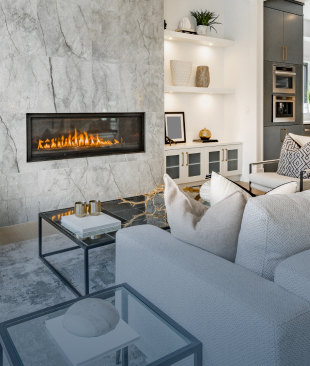History of the Fireplace: Ancient Beginnings
In all five inhabited continents, there is evidence of prehistoric man-made fireplaces. At first, a fireplace used to be a fire pit that provided warmth and heat for cooking. Over time, the fire pits were advanced into raised hearths in a building. The main challenge with early indoor fireplaces is that they produced a huge amount of irritating and toxic smoke. Venting the smoke was done by opening the windows or creating a hole in the roof. As seen in the country houses of the 16th and 17th centuries, the medieval great halls in large manors and castles had centrally located hearths where the fire burned and the smoke raised to a vent in the roof. To keep snow and rainwater from getting into the house through the vents, louvres were developed in the Middle Ages. Smoke canopies were also invented during the same period. The history of fireplaces places the invention of chimneys in Northern Europe in the 11th or 12 centuries. Chimneys finally fixed the smoke problem. They gave fireplaces draft and made it possible to install fireplaces in several rooms. Chimneys did not gain popularity right away because construction and maintenance were expensive. Early fireplaces were usually made of stone before brick was later adopted. A medieval finding that has revived in current times is that thick masonry walls opposite the fireplaces can absorb and re-radiate heat. It was also found that fireplaces with a rectangular form were far superior and that a grate offered better draft and sides that were splayed provided better heat reflection. Over the years, the fireplace design has gone through several improvements to be the object of decoration we have today. The history of the fireplace has also proved that some things have remained the same for centuries. This includes the tongs, which have remained unchanged since the 15th century.

Medieval Times: Fireplaces And Old Stone Chimneys
Often referred to as the Middle Ages or the Dark Ages, the Medieval era is the period between the 5th and 15th centuries. The period was characterized by a majority of the population living in small rural communities. The houses of the era were simple and made of natural materials. In the cold seasons, wood-burning fireplaces were a vital source of heat. People had moved from fire pits, and the fireplaces had advanced so much that they were built into walls. It was during this period that the fireplace ledge was introduced. At the time, fireplaces were not only a source of heat but also a place where people could gather for social exchanges. The fireplace was thus the center of life in homes. It was in the 12th century that French and English nobles started constructing stone-houses and castles. These buildings were fitted with a fireplace. To direct smoke out of the building without causing irritation, a stone chimney was added. This was also the period when people experimented with various chimney designs. However, with or without the louvres at the top, fireplaces were mainly built into the walls. The addition of the chimney in stone homes brought many benefits. One of the main advantages is that homes could be built with lower ceilings. This is because the risk of fires, which was a common problem when the fire sparked from a fireplace in the center of the room, was significantly lowered. Light from the fireplace also made a seat near it the perfect working space. On the flip side, only a few people could enjoy the heat because there was less room to gather around the fire. The world changed, and rooms were built to be smaller and more intimate. During the Medieval Times, fireplaces became more than a source of heat during the cold months. They became the social center of the house where families could gather and share stories. This is why the fireplace had a significant influence on literature and popular culture. It was the place where important characters met. In medieval poetry, fireplaces are the symbol of community and home. While fireplaces played an important role in the Medieval Times, they had their limitations. They were unattractive and inefficient and required a huge amount of wood to keep them burning. These limitations are what paved the way for new inventions, such as the addition of an ornate fireplace mantle.Invention Era: the Fireplace Mantel
The fireplace mantle, also known as the mantelpiece or chimneypiece, is the hood of the fireplace that projects over the fire grate to catch the smoke. It originated in the medieval times. The design has gone through numerous transformations over the centuries to become the decorative fireplace mantel we have in homes today. The term is used to refer to the mantel shelf, jambs and all the external accessories of the fireplace.How has the Fireplace Changed Over Time?
In the Renaissance period, the fireplace mantel had a carved oak upper portion that extended the whole width of the room. It used to have close to life-size statues on it, such as the statue of Charles V. The purer Italian style was introduced in the 17th century by Inigo Jones. This had a simple design and often had only the ordinary mantelpiece with a shelf and architraves. The design was abandoned towards the end of the 17th century and replaced with older and more effective moulding. The new design omitted the shelf. Architects went back to the Inigo Jones classic design in the 18th century. This design was later replaced by the Adam Brothers design, which is wood enriched with ornament and cast in moulds. For years, the fireplace mantle was the most ornamental feature of a room. However, as the sizes of the fireplaces have reduced and better heating methods have been introduced, the practical and artistic significance of the mantelpiece has lessened. Even so, adding it to your home will add a classic feel that elevates the ambience and value of your home. The best thing is that you can use elaborate designs to achieve the exact look you want. Painted mantels for fireplaces are also quite popular today.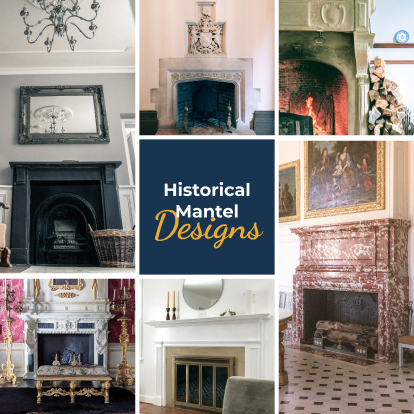
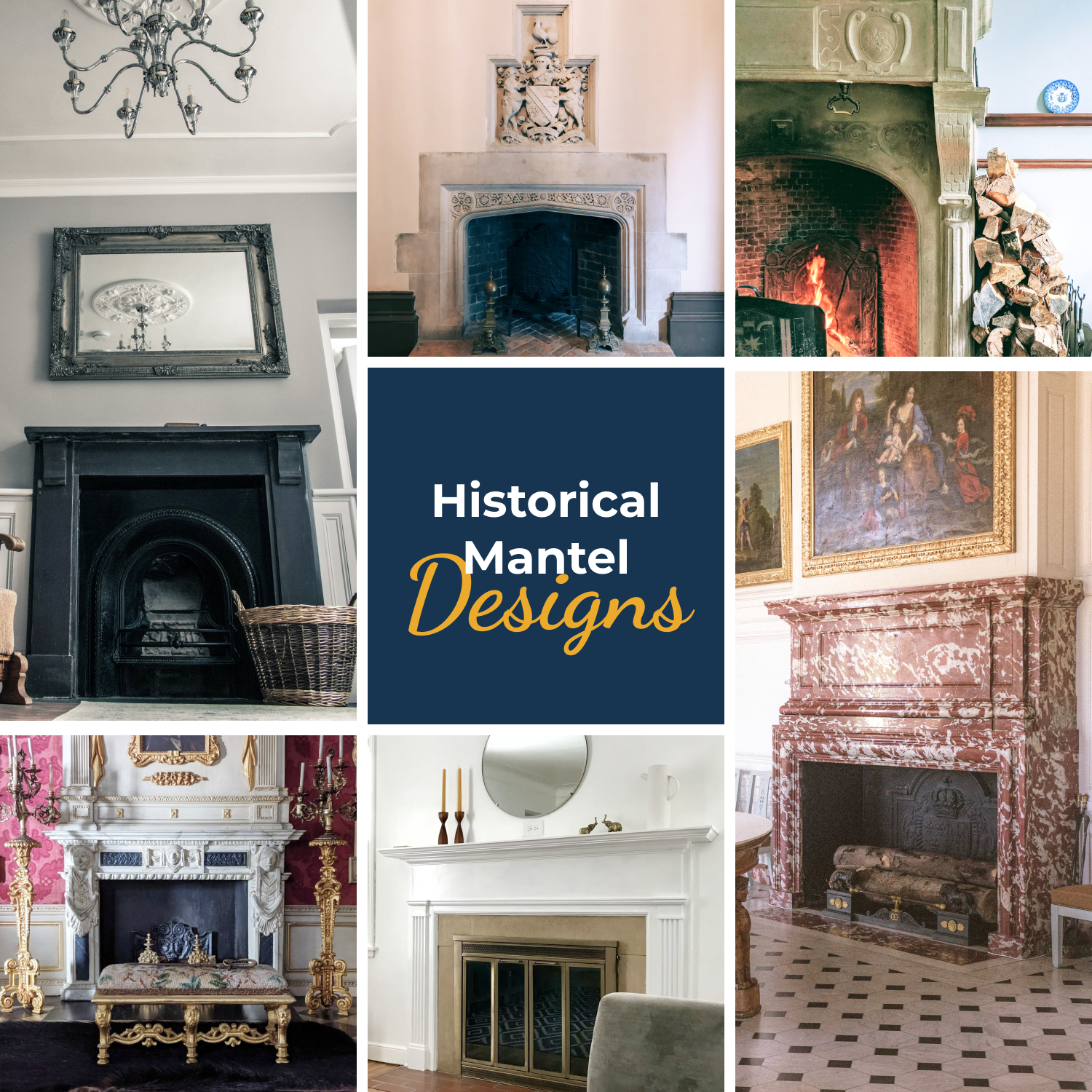
History of Fireplaces: The Rise of Accessories
Through the ages, fireplaces have been essential in the lives of people and had a wide range of uses. Initially, they were used to provide warmth and for cooking. Over time, the use evolved, and in some older homes, the fireplace no longer works. Even so, the hearth remains to be a symbol of the home. The mantelpieces are also mainly used to add to the décor and style of a home. A range of styles and designs are still added in modern homes to complement the interior décor. Whether you frequently use your fireplace or not, it is always good to have the right accessories. Fireplace accessories also make great gifts for people who have a fireplace. They can be placed on the fireplace shelf and used when the need arises. Here are the most popular accessories.Fireplace Screens
Fire screens are important fireplace accessories that not only add safety but also beauty to a home. According to the known history of fireplace screens, these accessories were mainly used to keep logs from falling out of the fireplace as well as stopping sparks from burning people. The decorative fire screens were also created in the Victorian era to direct the heat from the fireplace so that it was radiated evenly. Today, fireplace screens are designed not only to cover the fireplace so that pets and kids don’t get in but also to keep the sparks from flying onto the carpet when the fireplace is lit. There are so many designs available. When choosing one, think about the type of open fire you have.Fireplace Fenders
Another important accessory is the fireplace fender. This is a short screen that is placed in front of the fireplace to prevent ashes and sparks from escaping from the fireplace box. These accessories are quite decorative. They are designed to add elegance to the fireplace. Based on the history of fireplace fenders, 18th-century American fenders were made using bell metal or cast brass. They had sandwiched layers of the metals to increase strength. Today, craftsmen use sophisticated constructions to create pieces that are not only beautiful but also practical. You will be spoilt for choice when shopping for fireplace fenders today. Other popular fireplace accessories include:- Fire-glass: This is a decorative accessory that features a tempered glass design that can withstand any amount of heat. The fire glass goes over the gas burner in modern fireplaces.
- Gas log sets: This is an accessory that mimics traditional wood-burning fireplaces. The logs are made of cement or ceramic and last for years. They are meant to complement your interior décor.
- Damper cap: This accessory sits between the fireplace firebox and the chimney. It prevents cold air drafts.
- Fire grates
- Fireplace fan blower
- Reflective fire-backs
- Smoke guards
The Preway Fireplace: A Modern Marvel
There is no feeling better than enjoying the warmth from the flickering flames of a fireplace on a cool, breezy day. You feel at ease with the elements. If you don’t have a fireplace installed in your home, you can change that easily with the installation of a preway fireplace. The preway is an exemplary symbol of mid-century modern décor. It is distinguished by its cone shape and unique freestanding design. Initially available as a wood burner, today, you can find electric and gas-burning models. While the history of the preway fireplace places the design in the mid-20th century, this enamel, steel and metal fireplace significantly elevates any space it is installed in, whether indoors or outdoors. Thanks to the vibrant finishes, the preway became a statement-making addition to homes in the ‘60s and ’70s. It still remains a modern marvel thanks to the imaginative shapes and finishes. In addition to being the envy of your friends, several benefits come with getting a freestanding fireplace. The main benefits touch on the cost and the ease of installation. When compared to a traditional fireplace, preway fireplaces take up less time and money to install. There is also the fact that you can get this fireplace installed once you are sure of the perfect location, unlike a traditional fireplace that has to be factored into the floor plans. The Preway Fireplace Company is the manufacturer that made a dent in the course of the history of the fireplace with this innovative design. Today, there are more companies taking up the task of recreating these iconic freestanding fireplaces. You can find a colour and design that matches your personality. Finding a preway fireplace design that becomes the focal point of your living space is much easier.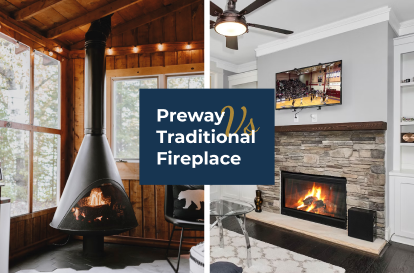
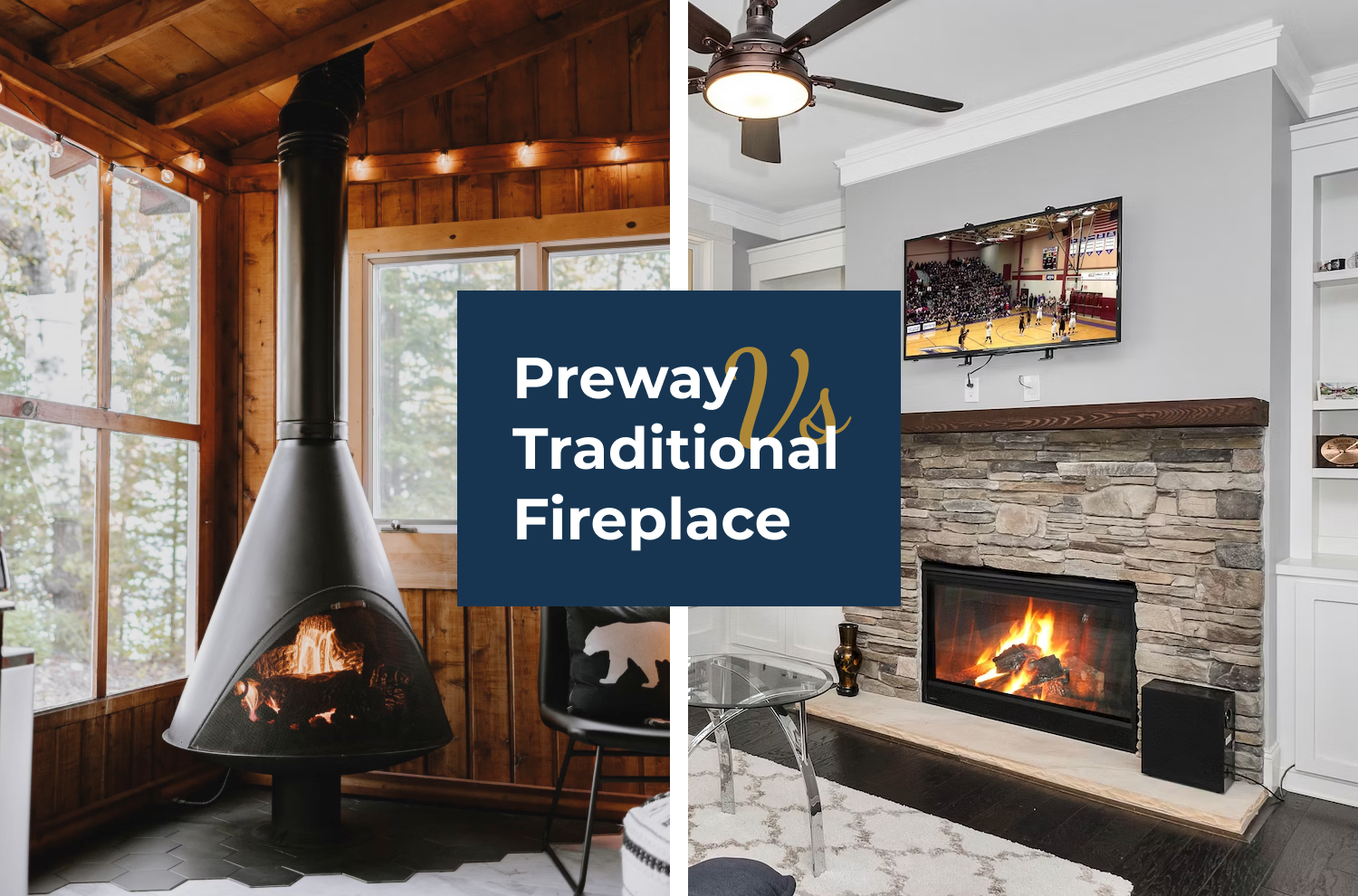
History of Fireplaces: Style Through the Ages
Although the exact birth date of fireplaces is unknown, they have been around for more than a thousand years, starting from the Medieval Times as fire pits to modern-day marvels used chiefly for decoration. Even with the lengthy history of the fireplace, its use has largely remained the same – providing warmth and bringing families together. The main difference between medieval time fireplaces and modern-day fireplaces is that modern fireplaces are not used for cooking, and they primarily use electricity or gas. There is also the fact that modern-day fireplaces are not used as the only source of heat. As a result, they are smaller and mainly installed as decorative elements in stone homes. Between the 1600s and 1700s, the fireplace was deep and wide. These used to be walk-in fireplaces that lacked a mantel. The Franklin Stove, invented in the 1740s by Benjamin Franklin, helped move the fireplace from the walls to the center of the room. It was not until the late 1700s that the fireplace started being thought of as a decorative element. More homes started building fireplaces that had mantels and included decorative elements like shell accents. The fireplace designed by Sir Benjamin Thompson in 1796 became the basis for modern-day fireplaces. The design was taller than wide, shallower, and smaller, with sharply angled covings on the sides. This helped disperse smoke more efficiently. This design continued to be used up to the 1900s. As households moved from wood to coal, the fireplace design shifted to the horseshoe-arched cast iron style. The Victorian age saw the introduction of more ornate fireplaces. The designs had columns and over-mantels. The fireplaces featured cast-iron inserts. The surrounding of the fireplace had decorative tiles. By the start of the 20th century, fireplace designs were much simpler. They included mantels and surroundings of either brick or stone. Today, fireplaces are available in many designs. They have also shifted from wood-burning designs to propane and electricity.What is the Symbolism of a Fireplace?
Many beliefs exist. In some early cultures, the fireplace was the hole in a home where bad energy or darkness could flow in, even with the windows and doors shut. Lighting the fire kept the evils out. In Chinese lore, the fireplace offers one of the elements needed to achieve harmony. All in all, since time immemorial, the fireplace has always been depicted as a symbol of home and warmth by almost all cultures.The Electric Revolution: The Advent of Electric Fireplaces
Electric fire was invented in 1912. While this invention did not gain popularity until the 1950s, it paved the way for the fireplace in a house called the electric fireplace. The electric fireplace is basically an electric heater that is designed to mimic a fireplace that burns wood, coal or gas. These fireplaces are usually installed inside conventional fireplaces and then plugged into the wall. They can be used as ‘flame only’, where they only show flames or as heaters, where they provide heat to a room. The flame effect has been around since 1988 when it was introduced by Dimplex, an Irish-based consumer electrical goods company. The company introduced a realistic wood-burning flame effect in 1995. In 2013, the company was able to introduce effects that combined realistic flickering flames using 3D LED logs. These advances will continue to shape the history of fireplaces until a new invention is made. There are many benefits that come with electric fireplaces:- Décor benefits: Electric fireplaces are beautiful and take up less space. There are many shapes, colours and sizes available to ornate and add warmth to your home.
- Convenience: Since the flames are not real, lighting the fireplace is instant, and you start enjoying the warmth almost immediately. Most units come with remote controls that can be used to change the colour and size of the flames, increase the level of heat, and so much more.
- Heating benefits: There is no chimney needed with electric fireplaces. This means heat will not be lost through the chimney. Electric fireplaces offer more control because they are designed to be central heating sources.
- Safety: The lack of real flames makes these fireplaces safer.
- Cost: The furnaces are less expensive to install and run.
The Fireplace: More Than Just a Heating Source
The history of fireplaces is both long and rich. Through the years, as the popularity of fireplaces spread across the world, new cultures popped up. While fireplaces are still considered an essential source of warmth and decoration, they are an intriguing element of symbolism in different cultures.Chinese Lore
According to Chinese beliefs, the fireplace plays an important part in bringing harmony into a household – Feng Shui. This is basically because fire is one of the four elements essential to life (earth, air, fire and water). Many people also believe wood for the next fire should be placed in the hearth between lightings.Early Cultures
In some early cultures, the fireplaces were a hole in a home through which darkness and bad energy could flow in. As a result, lighting the fireplace was believed to keep the demons and evil spirits out. In symbolism, the fire helped protect the house from bad energy.Ornamental Symbolism
If you have been keen on what is the history of fireplaces, you may have learnt why the mantels are as they are. The mantles have a shrine-like design because, in some cultures, fireplaces were considered to be some kind of shrine. Some cultures also placed images of deities or idols on the mantle, and a prayer was offered when lighting the fireplace.Home Cleansers
Lighting fireplaces was believed by many cultures to be a way of cleansing a home. When the fireplace was lit, the warmth overwhelmed the bad energy as it spread throughout the room.In Literature
It is literature that helped answer the question of when the fireplace was invented. In literature, the fireplace has been the symbol of home and shelter. There are so many myths that surround the fireplace. All the same, fireplaces have been some of the best inventions since the dawn of mankind.History of the Fireplace: Final Thoughts
The history of fireplaces proves that fireplaces have always been a necessity. They used to be the source of heat needed for warmth and cooking. Families also used to gather around them to share stories – not much has changed in terms of the purpose of a fireplace. However, throughout the years, the design of fireplaces has changed significantly from the walk-in fireplaces of the 1600s and 1700s to the much smaller and more efficient fireplaces we have today. Modern fireplaces are designed to be more ornate than practical. This is because the fireplace is no longer the primary source of heat in a home. Moreover, households are adopting the electric fireplace, which is compact, provides clean energy, and can be customized to fit any décor. Whether you are interested in a highly ornate fireplace or a traditional fireplace that heats the house, your options are simply unlimited in the modern day. You can even get decorative fireplaces that generate beautiful flames using LED lights or heaters that can be fitted into an existing fireplace. If your home doesn’t have a fireplace, you can opt for the preway fireplace, which is more compact and easy to install in any space. At The Zoroast Fireplace Store, we take pride in being the biggest showroom for fireplaces in Toronto. We are committed to making it easy to find a full line of high-quality and super-efficient gas and electric fireplaces with options for both indoor and outdoor spaces. Moreover, you can count on us to provide the best services when it comes to the installation, repair and maintenance of your fireplaces in Toronto. Our mission is to be the best one-stop shop for all your fireplace needs. We supply a wide range of fireplaces designed to be the focal point of any room or space in a home. Not sure what to pick? Give us a call. We are always happy to help.Toronto's Fireplace Store
Book an appointment
- +1 (416) 899-9998
- Unit 2, 535 Millway Avenue, Concord



 Website Design and SEO by dNovo Group | © 2024 All Rights Reserved – The Fireplace Store |
Website Design and SEO by dNovo Group | © 2024 All Rights Reserved – The Fireplace Store | 